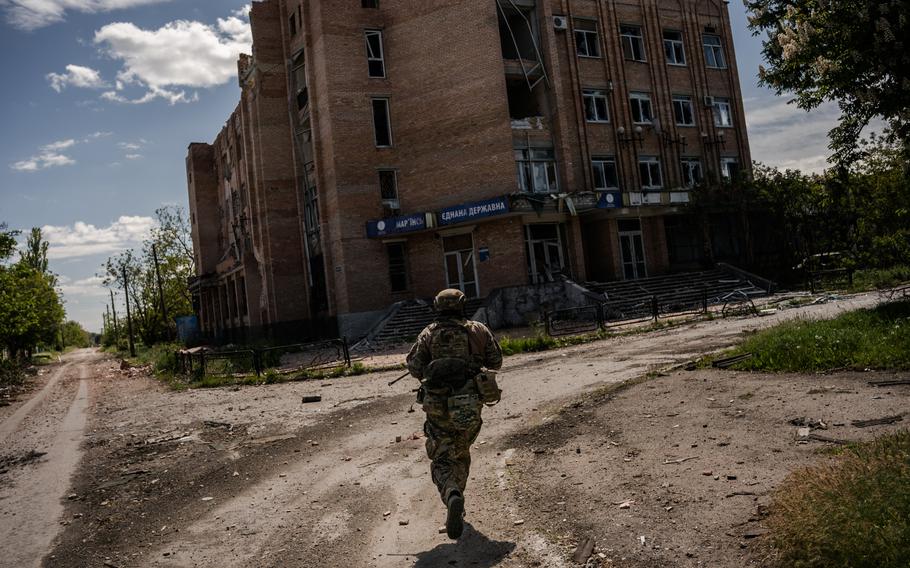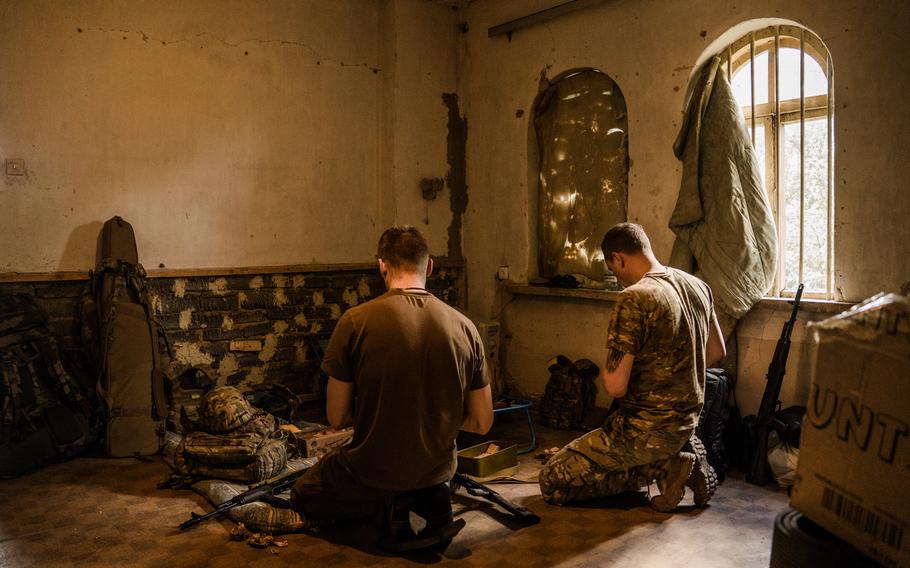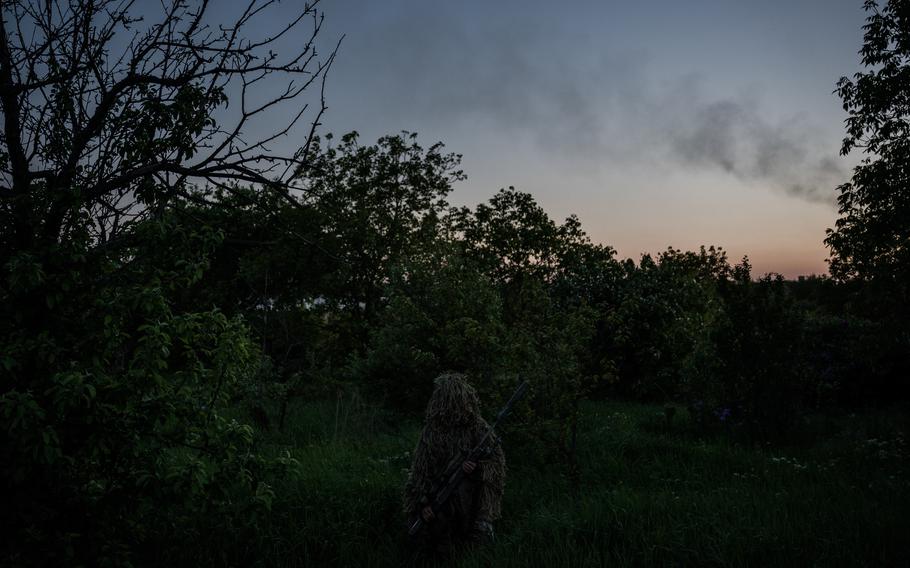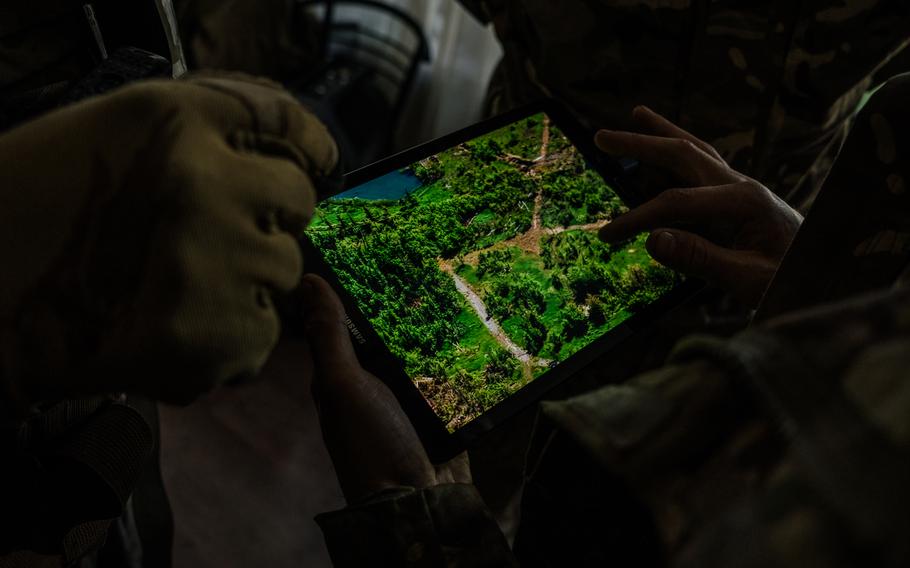
A Ukrainian sniper unit runs in a street of Maryinka, a town on the frontlines of the war with Russia, on May 17. (Wojciech Grzedzinski/For The Washington Post)
MARYINKA, Ukraine — Shortly after the Ukrainian sniper team arrived, a Russian shell slammed close to the operations base, rattling the windows and shaking the earth. A second one crashed moments later, then a third. Two Ukrainian drone operators arrived on yellow bicycles. They, too, had narrowly avoided a mortar attack.
On this volatile morning, the snipers' mission was to set up a forward position in this war-wrecked front-line town, vital to slowing the Russian advance in eastern Ukraine. It required a risky 300-yard dash across several street blocks, including a main road that the Russians were actively pounding. The unit had to avoid stepping on mines — or revealing themselves to locals who might tip off the Russians.
There was a lull in the artillery barrage.
"Let's go now," declared Dmytro Pyatnikovskiy, 38, the leader of the five-member team.
But then another shell rammed into the ground.
With Russia's military pushed out of Kyiv and on the retreat in Kharkiv, the war is now being waged largely in Ukraine's eastern Donbas region, in and around villages and towns like Maryinka. Russian forces are trying to push south from the town of Izyum and west from Moscow-backed separatist-controlled areas in a bid to fully take over Donbas, to which the Kremlin has laid claim on the grounds of defending its large Russian-speaking population.
But the Ukrainian troops here, a mix of soldiers and volunteers, have resisted stiffly, inflicting heavy casualties under conditions that Ukrainian President Volodymyr Zelensky has described as "hell." More than a month after Moscow shifted its focus to seizing the country's east, the Russians have made limited gains so far; in many areas, their offensive has ground to a stalemate.
A visit to Maryinka brought a rare close-up look at the current nature of the war in eastern Ukraine — fueled now by crushing artillery battles aided by drones and snipers — and showed why Russian forces have failed to break Ukraine's defensive lines.
"The Russians only fire with artillery and tanks now," said Curly, 35, a drone operator who gave only his nom de guerre. "They don't engage in close combat. Because they know they will get kicked by us. There are Russian ground units, but they are afraid to come to Ukrainian positions. We shell them with mortars.
"It's like badminton."

Ukrainian snipers load their rifles ahead of an operation in Maryinka on May 16. MUST CREDIT: Photo for The Washington Post by Wojciech Grzedzinski. (Wojciech Grzedzinski)
Another lull. Pyatnikovskiy, known to his team as Dima, glanced at his comrades and nodded. This was their window of opportunity.
Carrying their rifles, they moved out of the building and onto a side street. Curly, a welder before the war who has fought in the town since April and knows the terrain, joined them. As they reached an intersection, Curly suggested they go straight across - there had been less shelling up ahead. But Dima disagreed.
"Do you want to go through the park?" Dima asked. "There is nowhere to take cover."
"There is," Curly replied.
"There are at least walls here," said Dima, indicating the road to his left. Everyone followed.
They trotted alongside the walls of abandoned houses, some shattered by artillery, and past fences pocked with shrapnel. Tree-lined sidewalks were strewn with broken glass and torn open by mortar fire. The streets were ghostly. Not a resident was in sight.
As they neared the main road, the soldiers started to run.
The day before, the sniper team had set up camp in a village overlooking a lake roughly five miles outside Maryinka. They took food and other supplies, constructed a makeshift shower and dug a pit latrine.
Like many Ukrainian fighters, the five had been civilians before Russia invaded on Feb. 24. All from the southeastern city of Dnipro, they shared a passion for high-powered guns; all were members of a local shooting club called Wild Fields. They joined a volunteer corps and were sent to protect strategic sites. But what they really wanted was to put their skills to use. Now they were finally getting their chance. For three of them, Maryinka was their first front-line mission.
They were a motley crew. There was Alex, 34, a tall, blond boxing trainer; Andrei Kolupailo, 47, a towering businessman; and Oleksi Shapoval, 33, a wiry construction worker. Dima, also a construction worker, was a sniper trainer at the shooting club. All had purchased their own sniper rifles.

Oksana, a member of the team, with her rifle. (Wojciech Grzedzinski/For The Washington Post)
Oksana, 35, the curly-haired mother of a 5-year-old boy, was a former electrical engineer who had spent six years as a fire juggler in a circus that traveled around the world. She was now one of the small group of female snipers in the Ukrainian forces who can hit a target nearly a mile away.
"It is frowned upon in our society that a woman is in the military and doing this line of work," said Oksana, who for this reason declined to give her family name. "I may be judged later for decisions I made here. But it's not about gender to be patriotic and do your part for your country."
What team members lacked in front-line experience, they made up in confidence. They were bolstered by Ukrainian counteroffensives around Kharkiv that drove the Russians beyond artillery range and, in some cases, back to their border. Ukrainian aircraft and drones are actively bombing Russian positions in Donbas.
The snipers' primary mission was reconnaissance. But they also had orders to kill high-value targets, such as commanders or officers, whenever they saw an opportunity.
"Finally! I get to kill the occupiers," Oksana said. "We were trained to be here."
The Russians "have had losses in Kyiv," she said. "They have had losses now in Kharkiv. We are more than capable of fighting off the Russians. They will not push through here."
But the snipers also understood the volatility of the landscape, and how swiftly front lines in Donbas can shift. The region is made up of two provinces, Luhansk and Donetsk, portions of which were under Russian control before the war.
Russian forces have seized nearly all of Luhansk and besieged the strategic city of Severodonetsk from three sides. If the city falls, it could open the way for the Russians to push toward major cities such as Kramatorsk and Slovyansk.
The Ukrainians still control much of Donetsk, but after weeks of bombardment, the Russians have taken the port city of Mariupol. Keeping the Russians from seizing Maryinka has grown more urgent.
"It's very important," Kolupailo said. "If we lose this location, the Russians can advance in Donetsk."
This town has been in the crosshairs of war since 2014, when conflict erupted between pro-Russian separatists and Ukrainian forces. By the time a cease-fire was signed the following year, Maryinka had been shattered.
The town now is split between Ukrainian and Russian zones, lines that have been static for weeks. The sides are fighting a battle of attrition in which the enemy is rarely seen.
"It's harder to gain territory here because the Russians have had more time to fortify their positions," Dima said. "They have the same problem with pushing through the line into the Ukrainian side because the Ukrainian positions are also fortified.
"It's a game of moving backward and forward."
That hasn't stopped the Russians from trying. Last month, they reached a bridge roughly a mile from the operations base. The Ukrainians destroyed it, Curly said, but the Russians managed to cross the river and a battle erupted. The Ukrainians pulled back. "There is still a dead soldier from my unit lying there," Curly said.
But since then, the Russians have not moved.
"We have to fall back sometimes from our positions because we are getting shelled, we are getting bombed," Curly said. "We don't surrender the territory, but we retreat tactically.
"Now, every time the Russians try to advance with their tanks, they get shelled from the Ukrainian side. They cannot move forward from that position."
Each side flies surveillance drones to spy on the other and to identify targets to shell. Curly's drones have sent back images of Russian positions and tank movements, vital information for the mortar and artillery units.
Curly's younger brother, whose nom de guerre translates roughly to "crappy Ukrainian car," is an actor and aviation hobbyist. A few weeks ago, he devised tiny homemade bombs to attach to the drones. One night, Curly attached a thermal scope to a drone, spotted a group of Russian soldiers and dropped one of his brother's bombs on them.
When the Ukrainians spot a Russian drone overhead, they prepare for a barrage of artillery.
The Ukrainian forces here have received some U.S. and Western military support, including Javelin and NLAW antitank missiles. But they have far from enough heavy weaponry to launch counteroffensives, soldiers said. "If we have more of these weapons, it will tip the scale against the Russians," Curly's brother said.
Behind their own lines, the Ukrainians suspect that a large percentage of the civilians who have remained in Maryinka support Russia and are collaborating with the enemy. Locals accused of tipping off the Russians to Ukrainian positions have been apprehended and jailed. One elderly woman was caught carrying Russian passports and several burner phones, Dima said.
A group of suspected Russian sympathizers is living in a basement of a school. Recently, Ukrainian soldiers found two phones with suspicious numbers. Now it's a police matter, Curly said. The soldiers saw a benefit to keeping the residents in the school, which was near the operations base.
"Their presence actually helps because the Russians are not firing at this position," Curly said.

Snipers outside Maryinka check drone footage with soldiers. (Wojciech Grzedzinski/For The Washington Post)
For the snipers, there are additional challenges. Their reconnaissance mission means observing Russian forces to understand their number, the timing of their movements and the type and amount of equipment they have.
"It's very important for us to learn about all of the threats so Ukrainians won't become targets for Russians," Oksana said. "As snipers, we are trying to minimize the risks for all units on the ground and in the area."
But getting close enough to surveil the Russians is a risky endeavor. Both sides have planted mines and improvised explosives around the town. "Mines are everywhere," said Kolupailo. "You have to be very mindful of where you are stepping."
Another danger is the Russians spotting the snipers and shelling them. "The first obstacle is you have to choose the location wisely, Kolupailo said. "The second one is to sneak into the position quietly, and the third is to leave the location quietly."
But even the best-laid plans can go awry. Two weeks ago, a different team led by Dima set up position in a building. Other units had said their intelligence indicated there were no Russian positions nearby, said Shapoval (He was with Dima on that mission, too).
"A few minutes later, [a rocket-propelled grenade] struck a few meters away from us," Shapoval said.
The intelligence had been wrong. The snipers dismantled their guns and fled before they could be targeted again.
All these risks weighed on Dima, Shapoval and Alex as they ran across the main road. Oksana and Kolupailo remained in their camp, preparing to take the next shift.
The snipers crossed the road and walked swiftly past an abandoned market, its windows blown out, its roof battered by shells. As they turned into a yard with rusting, broken cars, a shell crashed.
"Go, go, go!" Dima yelled, ordering everyone to take cover near a wall.
They opened a red gate into a yard filled with debris to get to a former administrative building, its windows barricaded with sandbags and books. They gingerly climbed stairs littered with bricks and debris toward the top floor.
They were wary of mines or other booby traps. With the windows of the building large and open, they walked low to the ground, their backs hunched, to avoid appearing in a Russian sniper's crosshairs.
The Ukrainians' focus was on an emerald green hilltop nearly a mile away.
"The Russian positions are over there," Dima said, pointing out the window. "The sandbags you see are Ukrainian. Everything beyond that point is Russian."
In a corner of the room, away from the windows, the snipers set up a high-powered rifle and pointed the long scope at the hilltop. Alex pulled out a pair of binoculars and Dima directed him to observe the Russian position. Shapoval opened a tripod and placed a camera atop it. He looked through the rifle's scope.
The Russians were launching mortar fire, shells and Grad rockets toward the area. The rifle the snipers had set up could hit a target a mile away. They would be able to kill the Russian troops that were firing on them.
"This is going to be our position," Dima said.
- - -
The Washington Post's Serhii Korolchuk contributed to this report.